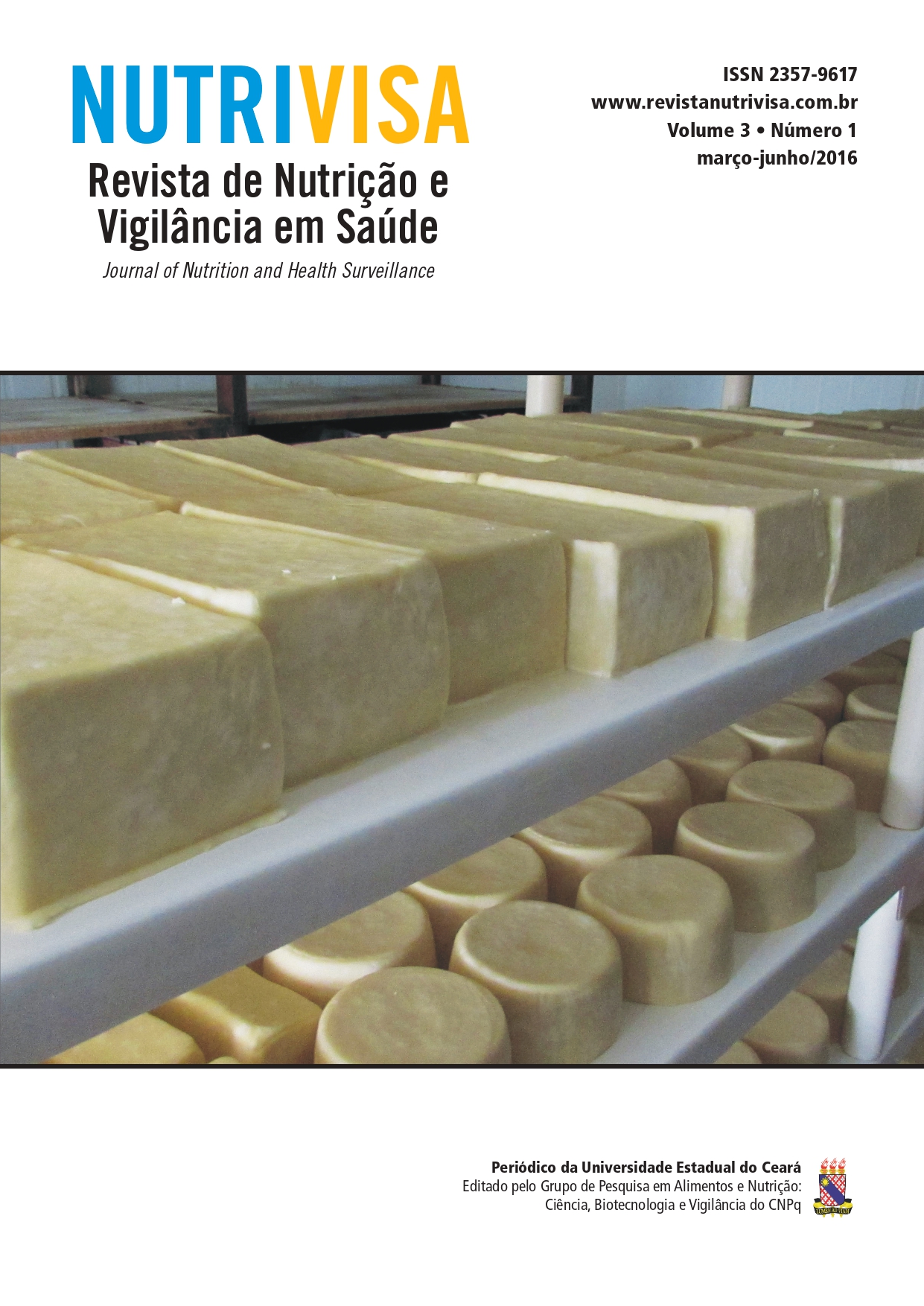Impact of tamarind flour consumption on Body Mass Index (BMI) of diabetic patients
DOI:
https://doi.org/10.59171/nutrivisa-2016v3e9046Keywords:
Tamarindus indica L., tamarind flour, BMIAbstract
Introduction: Tamarindus indica L. is a common fruit in tropical regions, produced in a large quantity at the Northeast, and it is easy to find. Objective: To investigate the impact of using a flour obtained from tamarind over BMI. Methods: This is a longitudinal study, which involved 82 patients with type 2 diabetes mellitus, who were attended by an institution of reference. They consumed a flour produced from tamarind for 30 days. All volunteers were interviewed with a form containing data about sex, age, color (self-reported), years of education, occupation, monthly income. Anthropometric measurements were taken, like weight, height and BMI. At the end of four weeks the weight was measured again. Results: There was overweight prevalence (70.73%) among the participants before starting the use of flour. After a month using the flour, it is clear that the final BMI of most participants remained at overweight (65.85%). Note that this percentage decreased from that at the initial and the BMI of some participants became classified as eutrophic (6.09%). There was a decrease in the percentage of obesity, which went from 29.26% to 28.04%. The average BMI values before and after the intervention were significantly different (p <0.05). Conclusion: The flour used was associated with improved nutritional status of the patients, with an increase of eutrophic and to the reduction on the proportion of obese.
References
AMÂNCIO, L.M.; SILVA, W.L.C.P.; SANTOS, V.M.L. Liofilização:
perspectivas para um novo mercado na região do Vale do São Francisco. Revista Semiárido de Visu, v.2, n.3, p.323-334, 2012.
ASSOCIAÇÃO BRASILEIRA PARA O ESTUDO DA OBESIDADE E DA
SÍNDROME METABÓLICA – ABESO. Diretrizes Brasileiras de Obesidade 2009/2010. ABESO – Associação Brasileira para
o Estudo da Obesidade e da Síndrome Metabólica. – 3.ed. São Paualo: AC Farmacêutica, 2009.
BAZZANO, L.A. et al. Dietary intake of whole and refi ned grain breakfast cereals and weight gain in men. Obes Res, v. 13, p.1952-1960, 2005.
BORGOGNONI, C.F.; et al. The influence of freezing rates on bovine pericardium tissue Freeze-drying. Brazilian Archives of Biology and Technology. v.52, n.6, p. 1493-1504, 2009.
BRASIL. Ministério da Saúde. Secretaria de Vigilância em Saúde. Departamento de Análise de Situação de Saúde. Plano de ações estratégicas para o enfrentamento das
doenças crônicas não transmissíveis (DCNT) no Brasil 2011-2012. Brasília: Ministério da Saúde; 2011.
CANUTO, G. A. B.; et al. Caracterização físico-química de polpas de frutos da Amazônia e sua correlação com a atividade anti- radical livre. Revista Brasileira de Fruticultura, v.32, n.4, p.1196-1205, 2010.
CIJU, R.J. Tamarind, the Indian Date: Growing Practices and Health Benefits. Faridabad: Ed. Agrihortico, 2014.
COUTO, A.N.; WICHMANN, F.M.A. Efeitos da farinha de linhaça no perfil lipídico e antropométrico de mulheres. Alim. Nutr., Araraquara, v. 22, n. 4, p. 601-608, 2011.
FELLOWS, P.J. Tecnologia do processamento de alimentos: princípios e prática. 2 ed. 602.p. Porto Alegre: Artmed, 2006.
FERREIRA, R.M.A; et al. Qualidade sensorial de geléia mista de melancia e tamarindo. Revista Caatinga, , v. 24, n. 2, p. 202- 206, 2011.
FIGUEIREDO, A.S.; MODESTO FILHO, J. Efeito do uso da farinha desengordurada do Sesamum indicum L nos níveis glicêmicos em diabéticas tipo 2. Rev. Bras. Farmacogn. Braz J. Pharmacogn. v.18, n. 1, p.77-83, Jan./Mar, 2008.
FUNG, T.T. et al. Whole-grain intake and the risk of type 2 diabetes: a prospective study in men. Am J Clin Nutr, v. 76, p.535-40, 2002.
GOOD, C.K. et al. Whole grain consumption and body mass index in adult women: an analysis of NHANES 1999-2000 and the USDA Pyramid Servings Database. J Am Coll Nutr. v.27,n.1, p.80-7, 2008.
HERNÁNDEZ-UNZON, H.Y.; LAKSHMINARAYANA, S.
Developmental physiology of tamarind fruit (Tamarindus indica L.). HortScience, Alexandria, v. 17, n. 6, p. 938-940, 1982.
JANEBRO, D.I. et al. Efeito da farinha da casca do maracujá- amarelo (Passiflora edulis f. flavicarpa Deg.) nos níveis glicêmicos e lipídicos de pacientes diabéticos tipo 2. Rev Bras Farmacogn., n18, p.724-32, 2008.
JENSEN, M.K. et al. Intake of whole grains, bran and germ and the risk of coronary heart disease im men. Am J Clin Nutr, n. 80, p. 1492-1499, 2004.
KOH BANERJEE, P. et al. Changes in whole grain, bran, and cereal fi ber consumption in relation to 8-year weight gain among men. Am J Clin Nutr n.80, p. 1237-1245, 2004.
LIU, S. et al. Relation between changes in intakes of dietary fi ber and grain products and changes in weight and development of obesity among middle-aged women. Am J Clin Nutr, n.78, p. 920-927, 2003.
MIRANDA, G.S. et al. Efeito do consumo da aveia e farinha da casca de maracujá sobre a glicemia e lipemia em um grupo de voluntários. Rev Ciênc Farm Básica Apl., v.35, n.2, p.245- 250, 2014.
MONTONEN, J. et al. Whole-grain and fi ber intake and the incidence of type 2 diabetes. Am J Clin Nutr, n. 77, p. 622-629, 2003.
MORAES, L.R.V. et al. Estudo comparativo da desidratação de frutas para fins de infusão, por método tradicional e liofilização. Revista Semiárido de Visu, v.2, n.2, p.254-264, 2012.
MUNTER, J.S.L. et al. Whole grain, bran and germ intake and risk of type 2 diabetes: A prospective cohort study and systematic rewiew. Plos Med., n.4, p. 261, 2007.
OLIVEIRA, C.M.; SICHIERE, R.; MOURA, A.S. Weight loss associated with a daily intake of three apples or three pears among overweight women. Nutrition, n.19, p. 253-256, 2003.
PASSOS, T. U. Consumo alimentar cearense: índice glicêmico e carga glicêmica de alimentos regionais e impacto potencial no risco de doenças crônicas não transmissíveis. Fortaleza, 2012. 92 p. Dissertação (Mestrado Acadêmico em Saúde Pública) – Universidade Estadual do Ceará.
SCHMIDT, M.I. et al. Chronic non-communicable diseases in Brazil: burden and current challenges. The Lancet. v. 377, p. 1949-61, 2011.
SILVA, S.T. et al. Farinha de banana verde não altera perfil lipídico e inflamatório de mulheres com excesso de peso. O mundo da saúde, v.39, n.2, p.174-81, 2015.
STEEMBURGO, T. et al. Intake of soluble fibers has a protective role for the presence of metabolic syndrome in patients with type 2 diabetes. Eur J Clin Nutr. n,63,v.1,p.127-33,2009.
WEELMAN, N.P. The Nutrition Screening Initiative. Incorporating nutrition screening and interventions into medical practice: a monograph for physicians. Washington D.C. US: American Academy of Family Physicians, The American Dietetic Association, National Council on Aging Inc., 1994.
WORLD HEALTH ORGANIZATION. Physical Status: the use and interpretation of anthropometry. Geneva,
Switzerland: WHO, 1995. (WHO Technical Report Series, n. 854).
Downloads
Published
How to Cite
Issue
Section
License
Copyright (c) 2016 Laís Marinho Aguiar, Helena Alves de Carvalho Sampaio, Antônio Augusto Ferreira Carioca, Tatiana Uchôa Passos

This work is licensed under a Creative Commons Attribution 4.0 International License.














